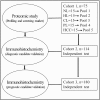Global proteomic profiling in multistep hepatocarcinogenesis and identification of PARP1 as a novel molecular marker in hepatocellular carcinoma
- PMID: 26883192
- PMCID: PMC4924674
- DOI: 10.18632/oncotarget.7316
Global proteomic profiling in multistep hepatocarcinogenesis and identification of PARP1 as a novel molecular marker in hepatocellular carcinoma
Abstract
The more accurate biomarkers have long been desired for hepatocellular carcinoma (HCC). Here, we characterized global large-scale proteomics of multistep hepatocarcinogenesis in an attempt to identify novel biomarkers for HCC. Quantitative data of 37874 sequences and 3017 proteins during hepatocarcinogenesis were obtained in cohort 1 of 75 samples (5 pooled groups: normal livers, hepatitis livers, cirrhotic livers, peritumoral livers, and HCC tissues) by iTRAQ 2D LC-MS/MS. The diagnostic performance of the top six most upregulated proteins in HCC group and HSP70 as reference were subsequently validated in cohort 2 of 114 samples (hepatocarcinogenesis from normal livers to HCC) using immunohistochemistry. Of seven candidate protein markers, PARP1, GS and NDRG1 showed the optimal diagnostic performance for HCC. PARP1, as a novel marker, showed comparable diagnostic performance to that of classic markers GS and NDRG1 in HCC (AUCs = 0.872, 0.856 and 0.792, respectively). A significant higher AUC of 0.945 was achieved when three markers combined. For diagnosis of HCC, the sensitivity and specificity were 88.2% and 81.0% when at least two of the markers were positive. Similar diagnostic values of PARP1, GS and NDRG1 were confirmed by immunohistochemistry in cohort 3 of 180 HCC patients. Further analysis indicated that PARP1 and NDRG1 were associated with some clinicopathological features, and the independent prognostic factors for HCC patients. Overall, global large-scale proteomics on spectrum of multistep hepatocarcinogenesis are obtained. PARP1 is a novel promising diagnostic/prognostic marker for HCC, and the three-marker panel (PARP1, GS and NDRG1) with excellent diagnostic performance for HCC was established.
Keywords: PARP1; biomarker; hepatocarcinogenesis; hepatocellular carcinoma.
Conflict of interest statement
We declare that there is no any ethical/legal conflicts involved in the article.
Figures




Similar articles
-
MCM family in HCC: MCM6 indicates adverse tumor features and poor outcomes and promotes S/G2 cell cycle progression.BMC Cancer. 2018 Feb 20;18(1):200. doi: 10.1186/s12885-018-4056-8. BMC Cancer. 2018. PMID: 29463213 Free PMC article. Review.
-
Proteomic profiling of hepatocellular carcinoma in Chinese cohort reveals heat-shock proteins (Hsp27, Hsp70, GRP78) up-regulation and their associated prognostic values.Proteomics. 2006 Feb;6(3):1049-57. doi: 10.1002/pmic.200500306. Proteomics. 2006. PMID: 16400691
-
Glutamine synthetase as an early marker for hepatocellular carcinoma based on proteomic analysis of resected small hepatocellular carcinomas.Hepatobiliary Pancreat Dis Int. 2010 Jun;9(3):296-305. Hepatobiliary Pancreat Dis Int. 2010. PMID: 20525558
-
Novel proteomic biomarker panel for prediction of aggressive metastatic hepatocellular carcinoma relapse in surgically resectable patients.J Proteome Res. 2014 Nov 7;13(11):4833-46. doi: 10.1021/pr500229n. Epub 2014 Jun 30. J Proteome Res. 2014. PMID: 24946162
-
Oncoproteomics of hepatocellular carcinoma: from cancer markers' discovery to functional pathways.Liver Int. 2007 Oct;27(8):1021-38. doi: 10.1111/j.1478-3231.2007.01533.x. Liver Int. 2007. PMID: 17845530 Review.
Cited by
-
The prognostic relevance of primary tumor location in patients undergoing resection for pancreatic ductal adenocarcinoma.Oncotarget. 2017 Feb 28;8(9):15159-15167. doi: 10.18632/oncotarget.14768. Oncotarget. 2017. PMID: 28122349 Free PMC article.
-
Knockdown of PARP-1 Inhibits Proliferation and ERK Signals, Increasing Drug Sensitivity in Osteosarcoma U2OS Cells.Oncol Res. 2016;24(4):279-86. doi: 10.3727/096504016X14666990347554. Oncol Res. 2016. PMID: 27656839 Free PMC article.
-
The prognostic value of decreased NDRG1 expression in patients with digestive system cancers: A meta-analysis.Medicine (Baltimore). 2018 Oct;97(41):e12455. doi: 10.1097/MD.0000000000012455. Medicine (Baltimore). 2018. PMID: 30313035 Free PMC article. Review.
-
A comprehensive review of immunotherapy in gastrointestinal tumors with a focus on the role of combination therapy with PARP inhibitors.Naunyn Schmiedebergs Arch Pharmacol. 2025 Jun 9. doi: 10.1007/s00210-025-04336-z. Online ahead of print. Naunyn Schmiedebergs Arch Pharmacol. 2025. PMID: 40488851 Review.
-
MCM family in HCC: MCM6 indicates adverse tumor features and poor outcomes and promotes S/G2 cell cycle progression.BMC Cancer. 2018 Feb 20;18(1):200. doi: 10.1186/s12885-018-4056-8. BMC Cancer. 2018. PMID: 29463213 Free PMC article. Review.
References
-
- EASL clinical practice guidelines: Management of chronic hepatitis B virus infection. J Hepatol. 2012;57:167–185. - PubMed
-
- Kobashi H, Miyake Y, Ikeda F, Yasunaka T, Nishino K, Moriya A, Kubota J, Nakamura S, Takaki A, Nouso K, Yamada G, Yamamoto K. Long-term outcome and hepatocellular carcinoma development in chronic hepatitis B or cirrhosis patients after nucleoside analog treatment with entecavir or lamivudine. Hepatol Res. 2011;41:405–416. - PubMed
-
- Kim SW, Yang HG, Kang MC, Lee S, Namkoong H, Lee SW, Sung YC. KIAA1114, a full-length protein encoded by the trophinin gene, is a novel surface marker for isolating tumor-initiating cells of multiple hepatocellular carcinoma subtypes. Oncotarget. 2014;5:1226–1240. doi: 10.18632/oncotarget.1677. - DOI - PMC - PubMed
-
- Zavattari P, Perra A, Menegon S, Kowalik MA, Petrelli A, Angioni MM, Follenzi A, Quagliata L, Ledda-Columbano GM, Terracciano L, Giordano S, Columbano A. Nrf2, but not beta-catenin, mutation represents an early event in rat hepatocarcinogenesis. Hepatology. 2015;62:851–862. - PubMed
MeSH terms
Substances
LinkOut - more resources
Full Text Sources
Other Literature Sources
Medical
Miscellaneous

